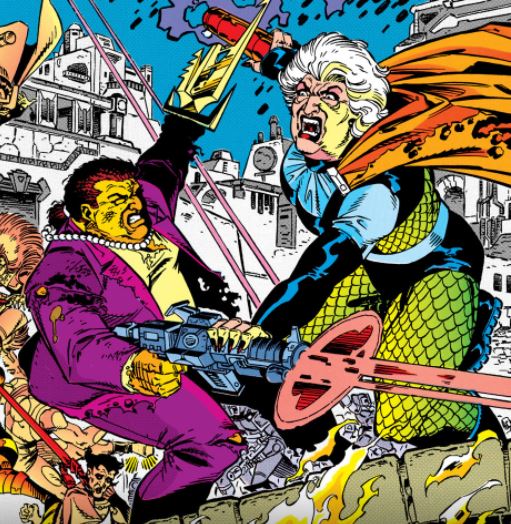
Welcome back! If you missed the last Suicide Squad retrospective, then you can catch up here. From now on, I will be breaking down Suicide Squad by volume rather than by individual issues. But fret not! There are still tons of things to discuss that I want to get into for each volume. And if you’re a new reader, check out the first piece in this series. For the Squad’s next adventure (Issues #31-#39), they take a detour to a little-known place called Apokolips. What could possibly await our titular heroes when they arrive? Definitely not an authoritarian, fascist dictator who personifies the very essence of evil, right?
A Return to Form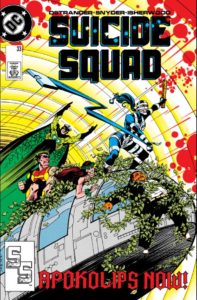
The Janus Directive crossover from the previous volume is easily my least favorite part of Suicide Squad so far. Thankfully, Suicide Squad #31-#39 is a return to form for the series, refocusing itself on what matters most: The members who make up the Squad. This includes the auxiliary members that make up the ground team, such as Flo and John Economos. However, this volume mostly concerns the wrapping up of Duchess’s character arc, a.k.a. Lashina of The Female Furies.
Apokolips Now
Introduced in Suicide Squad #10, Duchess’s true identity as Lashina quickly becomes apparent. Instead, the real question remains as to what exactly her motives truly are. But after biding her time at Belle Reve, it is revealed that Lashina has been somewhat stranded on Earth since Suicide Squad #3. Now, with a team of willing and unwilling participants, Lashina intends to go back to Apokolips and defeat her rival, the cunning Bernadeth, and take back her place as leader of The Furies. It is the most compelling “Duchess” has been, and it’s a satisfying conclusion to her arc.
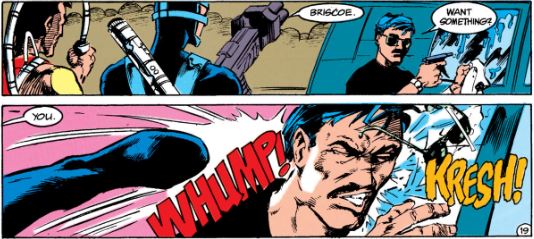
What I enjoy the most about the New Gods’ appearances is how their power levels are not downplayed for the sake of lifting up the protagonists. Remember in Issue #3 when The Furies plowed their way through Belle Reve like it was nothing? Lashina does the same thing here when she recruits and kidnaps Squad members. When it’s time to implement her plan, it’s as if a switch goes off in her head and she goes on auto-pilot: She is taking the Squad with her back home and no insignificant mortal can stop her. And, truthfully, no one does. That is, until Darkseid zaps her with his infamous and inescapable Omega Beams. The New Gods are appropriately god-like in their powers, and it makes for a fun excursion to Apokolips.

Aside from their power levels, the New Gods are quite alien as well. Artist John K. Snyder III perfectly captures Apokolips’s weird mix of sci-fi industrialism. From odd looking airships, towers of dirty pink and yellow smoke rising from the streets, to metal pipes constricting buildings and walkways, it is an admittedly suffocating and oppressive atmosphere. Disturbing statues of Darkseid’s head plastered everywhere serve as a friendly reminder as to who commands this wicked place.
Though this is the Suicide Squad, this story easily serves as a great introduction to Apokolips and the New Gods.
Personal Files
The real meat of Suicide Squad isn’t how many victories they achieve, but rather how each character deals with being in such a volatile group. This is best exemplified in the Personal Files issues. Each one details a variety of different members and their headspace after a brutal mission. However, this isn’t just relegated to the members dressed in spandex, but members of the ground team as well. It’s a testament to Ostrander and Kim Yale’s writing that they are able to allocate space in an issue to explore the non-metahuman characters yet still make it all feel necessary.
Take, for example, Mitch. He is the Squad’s plane mechanic, so not necessarily an interesting character who deserves much panel time. Yet, there are two pages dedicated to exploring who he is in Suicide Squad #31. You learn that he is an openly gay man struggling to reconcile this fact with his son, who refuses to even see his father anymore. It is an incredibly sincere moment for a book published in 1989. It’s also a bit gutsy, considering comicbooks have about 23 pages to tell a compelling story that will, hopefully, hook new readers and retain current ones.

The Personal Files issues in this series go beyond the initial Squad concept of expendable villains going on suicidal missions. They remind readers that even though these are felons, they are still humans beings. Count Vertigo’s candid therapy session is especially eye-opening from a mental health standpoint. In the world of capes and cowls, it is refreshing to see things from the perspective of a villain that isn’t just mustache-twirling villainy.
Living Up to the Name
The Squad has suffered casualties before, but most were one-and-done villains. Here, there are a few notable deaths that have a larger impact. In particular, Flo’s death hits surprisingly hard. Seeing the usually quippy warden of Belle Reve grieve over Flo’s death is tough to see, and it’s a reminder of their strong friendship, evidenced in past issues. It is especially striking when the issue cuts to a grieving Barbara Gordon. This is the first time she’s revealed to the reader as the mind behind Oracle, and her mourning speaks volumes about the friendship she shared with the younger Flo.
 Beginning this volume with the Personal Files story in issue #31 is an effective way to make Flo’s death impactful. When Waller cradles Flo’s lifeless body in issue #36, we are reminded of her previous losses. On top of her death, Waller also has to deliver the news to Flo’s mother. By the end of this volume, Waller walks down a dark path of her own creation. It will be interesting to see if this changes her behavior or reaffirms her desire to further weaponize her anger.
Beginning this volume with the Personal Files story in issue #31 is an effective way to make Flo’s death impactful. When Waller cradles Flo’s lifeless body in issue #36, we are reminded of her previous losses. On top of her death, Waller also has to deliver the news to Flo’s mother. By the end of this volume, Waller walks down a dark path of her own creation. It will be interesting to see if this changes her behavior or reaffirms her desire to further weaponize her anger.
Other deaths include Briscoe, a longtime member, and Dr. Light. Light doesn’t have a lot of pathos to him, but he has been the source of some great comic relief. His death is a great example of how the writing can seamlessly switch from hilarious to dark in an instant. The story then takes a “strange interlude” to what can only be assumed is Hell. Not only is Light doomed to bicker with his worst enemy for eternity, but the Devil also admits to being stuck in Hell with people he hates. Hell being a place where everyone is constantly annoyed with each other for eternity is a hilarious proposition that makes the interlude worthwhile.
The Mysterious Pie-Thrower
Pies! The mystery of the elusive Belle Reve pie-thrower is the silliest storyline in this series, but the conclusion is A+. Of course, it’s been Boomerang all along! And, of course, Boomerbutt doesn’t get off scot-free—at all. Instead, Waller sends him on a one-way trip to the Australian wilderness, effectively stranding him there for who knows how long. The comedic timing in this sequence is gold, and it’s a nice break from the dourness.
I should also mention my growing fondness for Punch and Jewelee. At first, they seem like a Joker and Harley knock-off. But as their appearances have grown, I have realized that their relationship is way cuter than Joker/Harley. Not to say that Joker/Harley’s relationship is cute in anyway; it’s actually quite abusive. But that just makes Punch and Jewelee standout more as a couple. No need to ship anything here, folks. Punch and Jewelee’s marriage is enough to give you the heart-eyes.
What’s Next for The Wall?
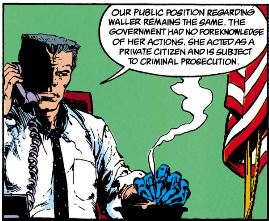 The Squad goes through phases. The first begins with issue #1 and ends with the public outing of the Squad in Suicide Squad #25. The next phase begins with The Janus Directive and control of the Squad being handed over to Sarge Steel. Waller’s imprisonment marks the beginning of a new era for the Squad. Steel’s phone conversation is, again, a nice callback to issue #31. In it, Waller’s sister mentions that her younger sister hates getting a taste of her own medicine. And as Waller sits in prison alone, it’s safe to say she has received a dose of it. She has become an expendable piece of the U.S. Government just as many Squad members have become under her leadership. So, what’s next for The Wall and the Suicide Squad?
The Squad goes through phases. The first begins with issue #1 and ends with the public outing of the Squad in Suicide Squad #25. The next phase begins with The Janus Directive and control of the Squad being handed over to Sarge Steel. Waller’s imprisonment marks the beginning of a new era for the Squad. Steel’s phone conversation is, again, a nice callback to issue #31. In it, Waller’s sister mentions that her younger sister hates getting a taste of her own medicine. And as Waller sits in prison alone, it’s safe to say she has received a dose of it. She has become an expendable piece of the U.S. Government just as many Squad members have become under her leadership. So, what’s next for The Wall and the Suicide Squad?
So there it is! The Squad is officially disbanded and Amanda Waller rots in prison for a year. Compared to The Janus Directive, this volume has some major consequences that should shift the Squad into a new and interesting direction. This is Suicide Squad at its best, and I can’t wait to dive into the next volume. The cover for issue #40 features Batman looming over Waller in her prison cell, a stark contrast to the confidence exuded by her on the cover of issue #10. What does Batman want? Find out next time when we dive into The Phoenix Gambit.


![[REVIEW] KANG THE CONQUEROR #1](https://geekd-out.com/wp-content/uploads/2021/08/kang-1-feat-150x150.png)

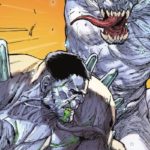
One thought on “[RETROSPECTIVE] ‘SUICIDE SQUAD’ (1987) VOLUME 5”